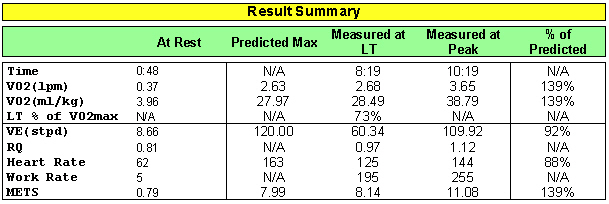Search by Catalog Number













VacuMed
4125 Market St #10
Ventura, CA 93003
(800) 235-3333
VO2 for Dummies, Chapter 2: |
|||
| Why measure VO2 ? | |||
|
You take a 15-minute walk during your lunch hour, are you fit? Your neighbor plays golf twice a week, is he fit? Your mother tends her garden every day, is she fit? Your cousin runs a marathon several times a year, is she fit? (Oh yah) Who is fit? Who is not? Resting VO2 is always expressed in ml/kg. You see terms like REE (Resting Energy Expenditure), RMR (Resting Metabolic Rate) and BMR (Basal Metabolic Rate). The differences are subtle, depending how you prepared for the test. Most resting VO2 tests, as a person in a fitness facility might experience, involves refraining from exercise, food and stimulating liquids for a few hours, then getting comfortable in a reclining position and finally breathing into a face mask for several minutes in order to analyze your exhaled breaths. Your REE or RMR is that O2 required to sustain your basic body function without any voluntary or involuntary (such as shivering) muscle movement. With that information, conclusions may be drawn about your dietary needs; about weight loss management, and adherence to a weight reduction program may be monitored. More on www.vacumed.com, click on "Dr. Andrew's Corner". VO2max testing typically involves a graded exercise test, meaning the workload is steadily increased to exhaustion. In a sub-maximal test workload is usually increased to a pre-determined heart rate or workload short of a maximal effort, or to a point that determines the lactate or anaerobic threshold (next chapter). Formulas have been published to predict VO2max from a sub-maximal test, but there are considerable doubts about the accuracy of such predictions. VO2max (Maximal oxygen uptake) was first described by Hill and Lupton in 1923 as "the oxygen intake during an exercise intensity at which actual oxygen intake reaches a maximum beyond which no increase in effort can raise it".(1) In other words, there is a point at maximal exercise where your oxygen consumption no longer increases, even though your workload does increase further. To be sure, you can perform this supra-maximal effort for a very limited time, typically less than a minute. VO2max can be considered THE universal measure of aerobic fitness. It allows you to compare couch potatoes with runners, rowers with tennis players, swimmers with spinners, and so many more. It does not tell you about their skill, just their relative ability to perform work. Let's look at two runners, equal in weight. Runner #1 has a maximum VO2 (VO2max) of 3 liters, runner #2 a VO2max of 3.3 liters. Yet runner #1 beats runner #2. This may be because runner # 1 has better skills, running efficiency, Nike shoes, or better steroids. But it could also mean that if runner #2 improved his skills, he has the potential to be the better runner. Modern, computerized VO2 measurement systems will compare your test results with "predicted" or so-called "normal" values. Such normal values have been published in the literature and are based on testing groups of "typical" populations, broken down by gender, age, height, and in some cases, ethnicity. A typical printout of such a VO2max test is shown below. 
Between resting and maximum VO2 measurements are the "Thresholds": Ventilatory, lactate, anaerobic. We will talk about this in a future chapter. In medicine, there are additional reasons for measuring VO2, but this may get too complicated for us Dummies. Click here to see a video of a typical VO2 test
(1) Hill, A. V. and H. Lupton, Muscular exercise, lactic acid, and the supply and utilization of oxygen. Q. J. Med. 16:135-171, 1923 Copyright (C) John Hoppe 2008 |
|||